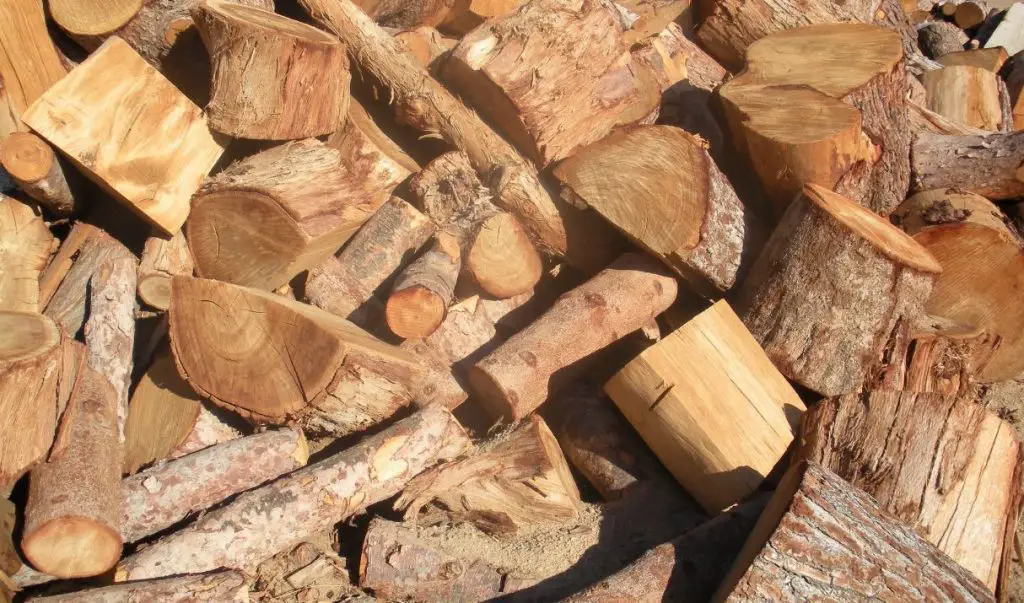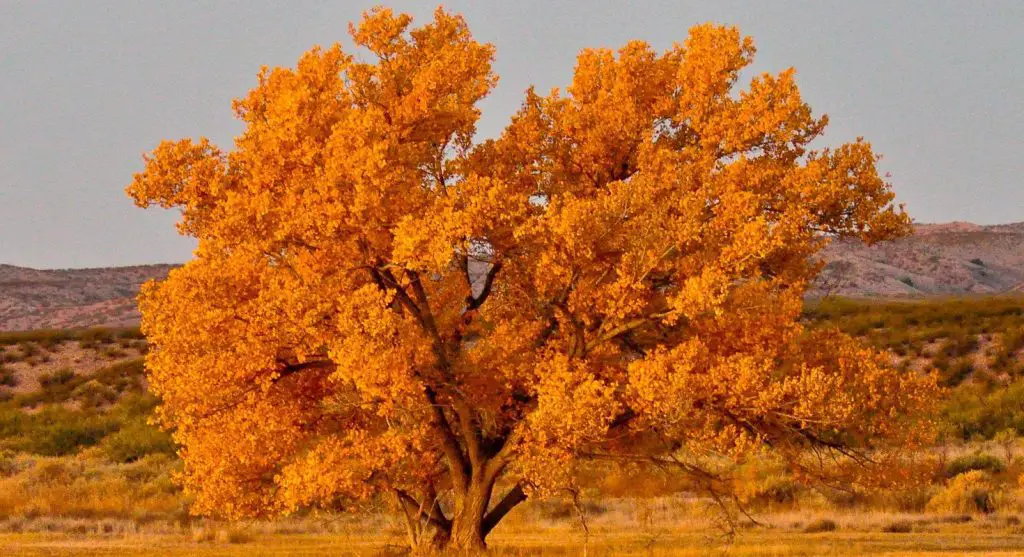Cottonwood is fair to moderate firewood option that produces good cooking coals but has a low heat production of only 15.8 million BTU/cord.
It seasons quickly but can be painful to process because of the sap in its branches and leaves. If this sap is not thoroughly removed by properly seasoning the wood, it can generate lots of smoke. Overall, cottonwood is far behind the premium hardwood alternatives.
Table of Contents
Summary
- BTU: 15.8 million BTU/cord
- Weight: 4600 lb/cord green
- Seasoning Time: 6-12 months
- Splitting Difficulty: Low
- Sap Content: Moderate
- Smoke: Moderate
- Smell: Minimal
Overall, cottonwood has some genuine advantages: it seasons quickly, is easy to split and doesn’t produce foul smells.
However, it has very low heat production, so you will need to stockpile significantly more than oak or ash. It contains a lot of sap in its branches and leaves which can produce a mess when chopping it, but generally, the trunk is easy to split.
I would only consider using cottonwood as my primary fuel source if I had no better hardwood available and would prefer to keep it as a fast igniting kindling.

Heat Production
The heat produced by cottonwood is very low – it is even lower than some softwood varieties. At 15.8 million BTU/cord compared to oak at 27 million BTU/cord, you will need to burn and stockpile significantly more wood to heat your home all winter. You will also notice the increased frequency of adding new logs to your fireplace.
If you are used to burning top-tier hardwoods then you will need to calculate the extra wood you will need to process and season. If you are used to buying four cords of oak for winter, you will need to get seven cords of cottonwood. Thankfully cottonwood trees are large, so you can get a high yield of wood per tree.
Another downside of cottonwood is the amount of ash that is produced. You will need to come up with interesting ways of using or disposing of all the extra ash you will be generating every night.
Smoke Production
Cottonwood does produce a moderate amount of smoke – more than oak. It doesn’t have a bad smell, but it doesn’t have a great smell either. On the other hand, unseasoned cottonwood can generate a lot of smoke from the sap content. Green cottonwood can also pop and spike as the pockets of resin ignite.
Seasoning Time
Cottonwood takes 6 to 12 months to season properly. It is essential not to burn cottonwood green because of its high sap content, which can cause more smoke to be produced. The best way to reduce this seasoning time is to stack your firewood in rows with good airflow, coverage from rain, and off the ground. Cottonwood contains a lot of moisture in the wood when it is green but seeps out quickly. Splitting cottonwood into smaller pieces also helps the drying process.
One of the main advantages of cottonwood is how much faster it seasons than other hardwood like oak at two years. It is a good option to add to your stockpile if you run out of time and need a quick top-up.
I personally recommend this General Tools Moisture Meter. It allows you to accurately gauge how wet your firewood is and whether it is sufficiently seasoned. Over time you can also see how quickly the moisture is dropping and how much longer you need to keep your firewood dropping until it is seasoned and ready to burn.
Press the sharp pins into the wood and you will quickly see the readout show the moisture ranging from 5% to 50%. It also has a Low/Mid/High indication depending on whether the wood is dry enough, so you don’t need to remember the actual values.

Burning Smell
Green cottonwood has a foul smell from the resin burning – just another reason to always avoid burning unseasoned firewood. My best comparison for the smell of green cottonwood is cat urine. You can also clearly smell it when chopping cottonwood from rounds into logs – it is distinct.
Seasoned cottonwood’s scent is slight – I have heard people describe it as similar to sage, but I can’t smell that myself.
If you are especially interested in odor for smoking meats or if you are sensitive to smell, have a read through this guide I have written about the best smelling firewoods to burn.
Creosote Buildup
Creosote is a black soot that typically forms when you burn unseasoned softwood, but it does form whenever any wood is burnt. It is dangerous and can cause chimney fires if not cleaned regularly. Cottonwood can produce more creosote than most other hardwoods because it burns at a lower temperature. I would treat cottonwood more like softwood because of its lower heat production.
Mixing cottonwood in with hotting burner woods can help to reduce the likelihood of creosote forming.
I recommend cleaning your chimney annually regardless of the type of firewood you burn to eliminate any potential buildups.
Splitting
Cottonwood is one of the softest hardwood varieties I have seen and split extremely easily. You must be careful to remove all branches containing a lot of sap – don’t put any large branches into your stockpile. Just keep the trunk.
It is famous for the sap that will surely stick all over your axehead or chainsaw. Make sure you clean it off thoroughly before putting your tools back in the garage, or you could find them badly corroded next time you pick them up.
If you buy cottonwood firewood rather than processing it yourself, ensure you aren’t getting any large branches in place of the trunk – this can significantly increase the smoke produced from the higher sap content.
Different Types/Species
Cottonwood trees are native to the United States and comprise a large part of the ecosystem. They grow tall and fast up to 140 feet, with a large canopy. They are deciduous and can grow to up to 6 feet in trunk diameter. They are members of the poplar family and are found throughout Europe and Asia. In this section, I have only discussed the most common firewood cottonwood trees in Black and Eastern cottonwood.
Black Cottonwood
The Black Cottonwood is native to Europe but spread through the western United States. It only reaches 90 feet tall on average and has a more conical shape. They are common in the Rocky Mountains and prefer open areas and moist soils.
Eastern Cottonwood
The Eastern Cottonwood is a huge tree that grows from Southern Canada through to Northeastern Mexico and well as the Eastern United States. It is one of the largest hardwood trees in North America and can grow a trunk of over 10 feet wide. It can live for over 300 years and can be broken down into subspecies of the Plaints Cottonwood in Nebraska and the Rio Grande Cottonwood in Texas.

Comparison to Other Woods
Here, I’ve taken some of the most popular firewoods to burn indoors and compared them to cottonwood firewood.
It is only fair to compare cottonwood to other hardwood species, which it doesn’t come close to comparing. The heat production is significantly lower, which leads to a lot of other problems – more to buy, more to chop, more to process, more to burn, and more ash to dispose of. I wouldn’t use cottonwood unless one fell right next to my stockpile. The sap content is annoying to clean off my chainsaw.
| Firewood | Million BTU/Cord (source) | Ease of Splitting | Coals | Overall Quality |
| Green Ash | 20 | Easy | Good | Excellent |
| Maple | 25 | Easy | Excellent | Excellent |
| Bur Oak | 26 | Easy | Good | Excellent |
| Cottonwood | 16 | Easy | Good | Moderate |
However, if I find myself short of firewood with winter fast approaching, then cottonwood is one of the few hardwood varieties I can season fast enough to burn within the same season.
FAQs
Can you burn cottonwood in a fire pit?
Cottonwood is a good option for burning in a fire pit while camping. It is cheap and readily available. As with all woods, ensure you only burn it after seasoning to avoid high smoke being produced from the sap content.
Can you burn cottonwood in a wood stove?
Cottonwood is ideal for burning indoors to heat your home all winter. Just keep in mind that the heat production is low, so you will need to add logs to the fire more frequently and will have more ash to dispose of in the morning. Green cottonwood also produces of a lot of foul-smelling smoke, so avoid burning it until it is properly seasoned.
How much does cottonwood firewood cost to buy?
Cottonwood is widely available and can be bought for around $200 per cord, depending on your location and the time of year. It also produces a lot of firewood per tree because of its tall, straight, thick trunks, which also brings down the price. Remember that you will need to buy significantly more cottonwood to produce the same amount of heat as oak.
Final Thoughts
To conclude, cottonwood doesn’t compare to the top-tier hardwood species like oak or maple. But it does compare to softwood varieties. It has a low heat production and produces a lot of ash, but it does season quickly and has a high yield of firewood per tree. It can also produce creosote because it burns at a lower temperature, so try blending it with higher heat production firewoods.
